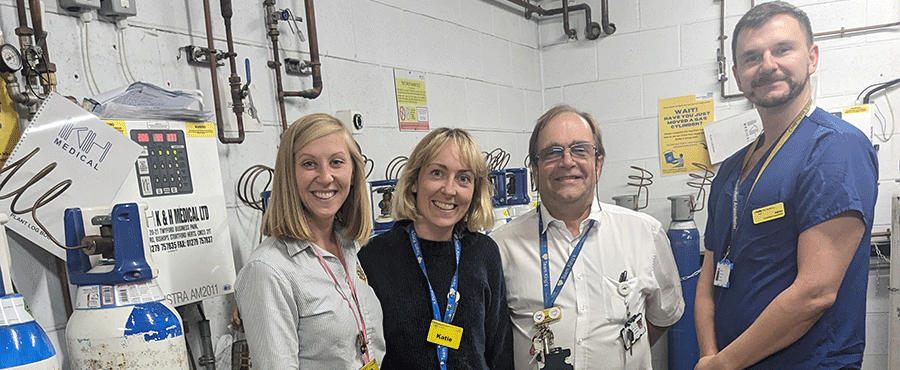Nitrous oxide: cutting waste to reduce emissions and save money

Summary
NHS trusts across the country have been exploring ways to reduce nitrous oxide wastage to cut anaesthetic gas emissions and save money without decreasing availability to patients.
For instance, Hull Women and Children’s Hospital changed procedures on labour wards and fixed valve leaks to reduce gas and air emissions by 80%.
Similarly, King’s College Hospital in London and the Royal United Hospital in Bath switched from large centralised nitrous oxide cylinders to small portable cylinders. This change led to a reduction in monthly nitrous oxide emissions from 333 tonnes to 150 tonnes (a 55% decrease).
Significant financial savings have also been realised as a result of the various approaches to optimise the use of nitrous oxide across trusts.
Trusts are continuing to explore other improvement opportunities, and UCLPartners has developed a toolkit titled Nitrous oxide toolkit: Reducing waste in NHS trusts to provide trusts with guidance on safely decommissioning systems, lessons learned, and best practices support a commitment to a net zero health service.
The issue
Use of anaesthetic gases, including nitrous oxide, currently makes up 2% of the NHS’ carbon footprint. The NHS Long Term Plan committed to lowering the carbon footprint from these gases, including nitrous oxide. This commitment is also reinforced in the Health and Care Social Act (2022), placing new duties on integrated care boards (ICBs), NHS trusts and foundation trusts to consider statutory emissions and environmental targets in their decisions.
Nitrous oxide is an anaesthetic and analgesic gas used as pain relief in a range of medical procedures. It accounts for a large proportion of the NHS’s emissions from anaesthetic gas, often due to wastage from inefficient or leaking systems.
Trusts across the country – including Hull University Teaching Hospitals, King’s College Hospital in London, and Bath’s Royal United Hospital – have all been exploring ways to improve storage and reduce wastage of nitrous oxide, ultimately helping to save the NHS money, reduce its carbon emissions, and meet its commitments in the NHS Long Term Plan.
The solutions and impact
Trusts across the country have developed a number of ways to address and improve the issues.
At Hull Women and Children’s Hospital, ‘gas and air’ (made up of 50% nitrous oxide and 50% oxygen) is often given to women in labour for pain and anxiety relief during childbirth. A multidisciplinary team including midwives, pharmacists, estates staff and porters tested the hospital’s gas and air connection points and identified large amount of gas and air leaked from the valves where gas entered the patients’ mouths.
Instead of having valves permanently plugged into the wall, midwives began keeping valves disconnected until gas and air was needed. The valve could then be quickly and easily connected to the wall to administer the gas, with no impact on patient care or speed of delivery. The seals were also improved to prevent gas escaping from the wall valve.
Both measures were found to significantly reduce the wastage of nitrous oxide. Keeping valves disconnected until patients needed to use gas and air reduced emissions by 80%, despite patient use remaining at the same level. Monthly emissions dropped from 395 tonnes to 43 tonnes and cylinders only needed to be changed every few weeks rather than every few days, leading to monthly cost savings of £3,000 and fewer emissions from cylinder deliveries (down from 250 to 33 per month).
At London’s King’s College Hospital and Bath’s Royal United Hospital, staff identified that nitrous oxide wasn’t being used in most routine procedures; and that the supply, drawn from a large, centralised cylinder, was far exceeding clinical need.
Teams at both trusts moved away from using these large cylinders of nitrous oxide (manifolds) – prone to non-harmful microleaks – to using nitrous oxide in smaller, portable cylinders directly on wards. This had a notable impact on reducing waste and emissions.
At King’s College Hospital, these portable cylinders helped to decrease monthly nitrous oxide emissions by 55%, from 333 tonnes to 150 tonnes. The trust expects to make significant cost savings from the switch: the annual cost of running a manifold is over £12,000, whereas mobile cylinders cost around £2,500. By year 10, it is projected that the trust will save over £75,000 from reduced nitrous oxide wastage. 4 nitrous oxide manifolds have been decommissioned.
At the Royal United Hospital, a multidisciplinary nitrous oxide working party helped engage colleagues in adopting the switch to smaller, portable cylinders of nitrous oxide. Theatre staff were trained how to use the portable cylinders using a ‘tea trolley’ teaching method, where training was taken directly to operating theatres to minimise disruption to clinical care.
Approximately 75% of staff were trained within 3 weeks, enabling the trust to quickly introduce portable cylinders to all theatres and cap off the piped nitrous oxide supply.
By switching from manifolds to portable cylinders, Bath’s Royal United Hospital reduced their annual order of nitrous oxide from more than 2 million litres to 13,500 litres, cutting the trust’s emissions by 2% and saving £7,000 a year.
Find out more
UCLPartners has published a comprehensive new resource – Nitrous oxide toolkit: Reducing waste in NHS trusts – that provides advice and best practice examples to help trusts reduce their nitrous oxide wastage without impacting patient use or experience.
Trust contacts
- Hull University Teaching Hospitals NHS Trust: Marc Beaumont (Sustainability Lead): marc.beaumont@nhs.net
- King’s College Hospital NHS Foundation Trust: Laura Stevenson (Project Lead): laura.stevenson@nhs.net
- Royal United Hospitals Bath NHS Foundation Trust: Abigail Mann (Project Lead): abigail.mann@nhs.net
